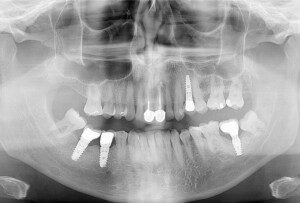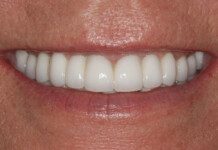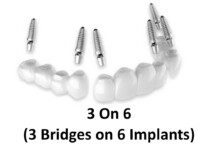
Introduction
Dental implants provide a highly successful solution for replacing missing teeth that is durable and aesthetically pleasing. They are designed to mimic the form and function of natural teeth, offering patients a long-term remedy for tooth loss. Despite their high success rate, there are instances when dental implants fail or complications arise, necessitating their removal. Understanding the intricacies of dental implant removal, including the reasons behind such a procedure, the risks involved, and the subsequent steps for oral rehabilitation, is crucial for patients and dental professionals alike. This discussion aims to shed light on the process of dental implant removal, explore the risks and complications associated with this procedure, and examine the alternatives and follow-up treatments available to ensure the continued oral health of the patient.
Fortunately, in our practice, instances where a dental implant removal cannot be successfully replaced with another implant are rare.
Reported predictors for implant success and failure are generally divided into 4 categories:
- Patient-related factors (e.g., general patient health status, smoking habits, quantity and quality of bone, periodontal conditions, oral hygiene maintenance, etc),
- Implant characteristics (e.g., dimensions, coating, loading, etc),
- Implant location, and
- Clinician experience.
Reasons for Dental Implant Removal
Dental implants are widely recognized for the role they play in replacing missing teeth. They are the standard of care due to their high success rates (97%) and durability (decades). However, there are some instances, when dental implant removal becomes necessary due to various reasons. The most common being:
- Infection and Peri-implantitis: This is a bacterial infection that affects the tissues surrounding the implant, leading to inflammation. In severe cases, it can lead to the deterioration of the jawbone supporting the implant. Established risks are: Plaque accumulation, periodontal disease, cigarette and smokeless tobacco use, hyperglycemia and obesity.
- Failure of Osseointegration: Osseointegration refers to the process by which an implant integrates with the jawbone. Failure occurs when the implant does not properly bond with the bone, rendering it loose. This is often caused by poor bone quality ior quantity.
- Poor Bone Quantity or Quality: If the bone volume or density in the implant site is isufficient when the implant is placed, over time, it can result in bone loss. This can occur when the implant is placed in an area with inadequate bone quality or quantity, or if there is progressive bone resorption after the implant is placed.
- Mechanical Failure: Components of the implant system, such as the screw, the crown/bridge, or the implant itself, can break due to excessive force or wear and tear. One common cause of this is excessive grinding or clenching of the teeth. (This is precisely why we provide all of our dental implant patients who grind or clench with a nigh guard to wear at night. This protects their investment and prevent breakage of prostheses and/or dental implant failure.)
- Poor Placement: If implants are not placed in the proper position (too high, too low, too far to one side or the other, placed crooked, or just not in the ideal place for supporting the prosthesis being made to fit on top of it, etc); If the bone gets overheated during the procedure and is compromised (this is from the Dr. drilling into the bone too fast and not cooling the bone well enough during the drilling process); If the site is overprepared (over-drilled, leading to poor osseointegration), or trauma during surgery, etc.
- Health Conditions: Conditions such as uncontrolled diabetes or osteoporosis can affect bone density and stability, impacting the success of dental implants.
- Lifestyle/Habits: Smoking is one of the leading causes of dental implant failure. (Particularly during the initial healing phase.)
The Dental Implant Removal Process:
- Assessment and Planning: The first step involves a thorough examination, including imaging tests such as X-rays or CT scans, to assess the implant’s condition and condition of the surrounding bone structure. This assessment helps us to better understand and gauge the complexity of the removal process and plan the procedure accordingly.
- Anesthesia: To ensure the patient’s comfort, local anesthesia is administered around the implant site. In cases where the patient is anxious or the procedure is expected to be lengthy, IV (conscious) sedation might be considered.
- Incision and Exposure: The gum tissue around the implant is carefully incised to expose the implant and the surrounding bone. This step is done with precision to minimize tissue damage and facilitate better healing post-removal.
- Removing the Implant: The method of removal depends on the implant’s condition and its integration with the bone. If the implant is loose, it may be removed directly with dental instruments, similar to a tooth extraction. However, if the implant is partially Osseo integrated (bonded with the bone), specialized tools and techniques are required. Deliberately delicate techniques are employed to detach the implant from the bone as gently as possible. A trephine bur (a hollow, cylindrical drill) is often used in this scenario to remove a small section of bone around the implant. The goal is to extract the implant with absolute minimal bone loss.
- Debridement and Cleaning: Once the implant is removed, the site is thoroughly cleaned and any infected tissue or debris removed. This step is crucial to prevent infection and promote healing.
- Bone Grafting (if necessary):In cases where significant bone loss has occurred, bone grafting may be performed to enhance the site for potential future implant placement. The grafting material can be synthetic, from the patient (autograft), or from another source (allograft or xenograft).
- Closure: The gum tissue is then sutured back into place. Sutures may be resorbable or require removal after a certain period.
- Post-Operative Care: The patient is given detailed aftercare instructions, including oral hygiene practices, medications for discomfort and infection control, and dietary recommendations. Follow-up appointments are scheduled to monitor healing and discuss any further treatment if needed.
Risks and Complications
As with any surgical procedure, the removal of dental implants involves some risks and possible complications, which include:
- Infection: Surgical interventions carry the risk of infection, so following post-op instructions and keeping the site clean is imperative.
- Bone Loss: Removing an implant can result in further loss of bone, particularly if the bone has already been weakened.
Minimizing Risks and Complications
With the removal of dental implants, to mitigate these risks, several strategies can be employed:
- Thorough Pre-Operative Assessment: Utilizing imaging techniques such as X-rays or CT scans to plan the removal procedure meticulously.
- Aseptic Technique: Ensuring a sterile surgical environment and using antibiotics as preventive measures against infection. Our office takes this VERY seriously.
- Gentle Surgical Techniques: Employing methods that minimize trauma to the bone and surrounding tissues, potentially using specialized tools designed for implant removal. This procedure requires precision and patience in removing the device, while preserving as much of that precious bone as is possible.
Alternatives and Follow-Up Treatment
After a dental implant is removed, various alternatives are available for replacing the missing tooth or teeth:
- Another Dental Implant: When conditions are favorable, another implant can be placed after allowing time for healing and bone grafting. This is the “normal”, in our practice. (That most all failed implants are able to be successfully replaced.)
- Dental Bridge: A bridge can be an option if adjacent teeth are healthy and can serve as anchors.
- Removable Dentures: For patients with no teeth remaining, removable dentures may be a practical and less invasive alternative.
Timing for New Implants or Procedures
The timing for placing a new implant or undergoing other restorative procedures depends on several factors:
- Immediate Replacement: In some cases, it’s possible to place a new implant immediately after removal, especially if there is adequate bone and no infection.
- Delayed Replacement: Often, a period of healing is necessary, especially if bone grafting is required to rebuild the site. This can take several months to ensure the area is ready for a new implant.
The Re-Implantation Process
Meticulous removal of granulation tissue on the failed implant site and the use of wider implants could improve the outcome of re-implantation. When wider implants are not an option, bone grafting followed by the replacement of another similar or same-sized implant is a good bet.
Although more often than not, we are able to replace a fasiled implant with another one, re-implantation might not be recommended in certain scenarios, such as with:
- Significant Bone Loss: If bone loss is extensive and cannot be effectively addressed through grafting, alternative treatments might be preferable.
- Medical Conditions: Certain systemic conditions that affect bone healing and density may preclude the placement of another implant.
Conclusion
The removal of dental implants, while not commonplace, is a necessary procedure under certain circumstances. Whether due to infection, failure of osseointegration, mechanical failure, or health conditions affecting the implant’s stability, the decision to remove an implant is made with the patient’s overall health and well-being in mind. Despite the potential risks and complications, with careful planning, skilled surgical intervention, and appropriate follow-up care, the impact on the patient’s oral health can be minimized. Successful REplacement of an implant is possible more often than not.
For those extremely rare cases where a second placement just is not possible, alternatives to dental implants, such as bridges or dentures, provide viable options for tooth replacement. These options ensure that patients can continue to enjoy a functional and aesthetically pleasing smile. Ultimately, the journey from dental implant removal to full oral rehabilitation underscores the importance of a tailored, patient-centric approach to dental care, emphasizing the need for ongoing communication, evaluation, and adaptation of treatment plans to meet the evolving needs of each patient.
More info on the topic from the National Library of Medicine: https://www.ncbi.nlm.nih.gov/pmc/articles/PMC4327689/






